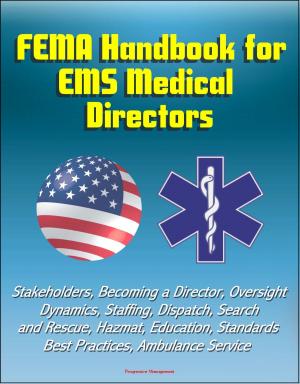FBI Report: Improving Our View of the World: Police and Augmented Reality (AR) Technology - Biological/Psychological Considerations, Legal Issues, Possible Criminal Uses
Nonfiction, Social & Cultural Studies, Political Science, Politics, Law Enforcement| Author: | Progressive Management | ISBN: | 9781301102952 |
| Publisher: | Progressive Management | Publication: | May 3, 2013 |
| Imprint: | Smashwords Edition | Language: | English |
| Author: | Progressive Management |
| ISBN: | 9781301102952 |
| Publisher: | Progressive Management |
| Publication: | May 3, 2013 |
| Imprint: | Smashwords Edition |
| Language: | English |
We live in a rapidly changing society that is driven by higher and higher levels of technological advancement. New technologies are creating greater and more powerful capabilities for humanity, offering opportunities for change that are fundamentally deeper than additional hours of relaxation and greater economic prosperity. New capabilities are changing the way people view the world and their place in it. One of the 21st century's emerging and potentially powerful technologies is Augmented Reality (AR). Sports fans view one popular use of AR technology each weekend: the major networks augment their coverage of professional football by superimposing yellow "first-down" lines over the gridiron. While not interactive, this is AR in its simplest form. Advanced AR overlays virtual (computer-generated) images onto a person's real-world field of vision or into a real-world experience in a way that improves and enhances the ability to accomplish a wide variety of tasks and assignments. Situational awareness is greatly improved, theoretically allowing one person equipped with AR technology to do the same amount of work as three unequipped individuals.
While still years from perfection, wearable AR units are currently under development: the Naval Research Laboratory is working to develop the Battlefield Augmented Reality System (BARS). The BARS will be a wearable device incorporated into a soldier's personal equipment load for the purpose of enhancing his or her combat capability by gathering and displaying realtime intelligence, overlaying surrounding geographic information such as maps and floorplans, presenting high priority sensor data, providing improved optical capabilities and maintaining constant communications with team members and higher headquarters.
AR technology will also have a dramatic impact on policing, creating innovative methods for combating crime and terrorism. It will also afford criminals and terrorists new opportunities for exploiting, disrupting and harming society. In order to be used effectively, police personnel need to fully understand current AR capabilities and what will emerge in the coming decades. Some possible AR applications for policing include:
Real-time language translation along with data on cultural customs and traditions, Real-time intelligence about crimes and criminals in the patrol area, Facial, voice-print and other biometric recognition data of known criminals to allow instantaneous identification, Integration of chemical, biological and explosive sensors to immediately notify officers of any local contamination and recommend appropriate protective measures for themselves and the public, Scalable, three dimensional maps, complete with building floor plans, sewer system schematics, public utility information and public transportation routes, accessed at will to improve situational awareness and response to problems, and Patrol car operator data and regional traffic management information on a heads-up display to make driving safer and more efficient, especially in pursuit and rapid response situations.
Introduction * Methodology * Results * AR Technology * Research Site Visit * Potential Police Applications of AR * AR Implications for Policing * Technical Considerations * Financing * System Support * Biological/Psychological Considerations * Legal Issues * Possible Criminal Uses of AR Technology * Next Steps * Conclusion * Suggestions for Further Research * References
We live in a rapidly changing society that is driven by higher and higher levels of technological advancement. New technologies are creating greater and more powerful capabilities for humanity, offering opportunities for change that are fundamentally deeper than additional hours of relaxation and greater economic prosperity. New capabilities are changing the way people view the world and their place in it. One of the 21st century's emerging and potentially powerful technologies is Augmented Reality (AR). Sports fans view one popular use of AR technology each weekend: the major networks augment their coverage of professional football by superimposing yellow "first-down" lines over the gridiron. While not interactive, this is AR in its simplest form. Advanced AR overlays virtual (computer-generated) images onto a person's real-world field of vision or into a real-world experience in a way that improves and enhances the ability to accomplish a wide variety of tasks and assignments. Situational awareness is greatly improved, theoretically allowing one person equipped with AR technology to do the same amount of work as three unequipped individuals.
While still years from perfection, wearable AR units are currently under development: the Naval Research Laboratory is working to develop the Battlefield Augmented Reality System (BARS). The BARS will be a wearable device incorporated into a soldier's personal equipment load for the purpose of enhancing his or her combat capability by gathering and displaying realtime intelligence, overlaying surrounding geographic information such as maps and floorplans, presenting high priority sensor data, providing improved optical capabilities and maintaining constant communications with team members and higher headquarters.
AR technology will also have a dramatic impact on policing, creating innovative methods for combating crime and terrorism. It will also afford criminals and terrorists new opportunities for exploiting, disrupting and harming society. In order to be used effectively, police personnel need to fully understand current AR capabilities and what will emerge in the coming decades. Some possible AR applications for policing include:
Real-time language translation along with data on cultural customs and traditions, Real-time intelligence about crimes and criminals in the patrol area, Facial, voice-print and other biometric recognition data of known criminals to allow instantaneous identification, Integration of chemical, biological and explosive sensors to immediately notify officers of any local contamination and recommend appropriate protective measures for themselves and the public, Scalable, three dimensional maps, complete with building floor plans, sewer system schematics, public utility information and public transportation routes, accessed at will to improve situational awareness and response to problems, and Patrol car operator data and regional traffic management information on a heads-up display to make driving safer and more efficient, especially in pursuit and rapid response situations.
Introduction * Methodology * Results * AR Technology * Research Site Visit * Potential Police Applications of AR * AR Implications for Policing * Technical Considerations * Financing * System Support * Biological/Psychological Considerations * Legal Issues * Possible Criminal Uses of AR Technology * Next Steps * Conclusion * Suggestions for Further Research * References















